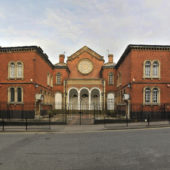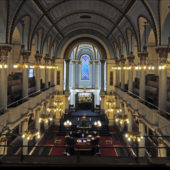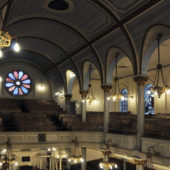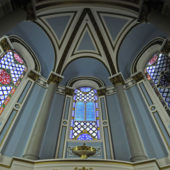The oldest still-functioning “cathedral synagogue” of England.
Birmingham’s Jewish community is one of the oldest in England. Its manufacturing industries attracted the first Jewish settlers. It also attracted Jewish peddlers, who would travel the countryside, “flogging their wares.” There is written record of the first synagogue in Birmingham being in used in 1779. This reference, in William Hutton’s History of Birmingham (1780), was to a synagogue in the area known as “the Froggery”. Since only about twenty Jewish families lived in Birmingham at that time, it is most likely that this synagogue was converted from a domestic house.
By 1809, another synagogue was built in Birmingham, on Severn Street (the building still stands today). By the 1850s, the Jewish population of Birmingham was approximately 700 people, outgrowing the Severn Street Synagogue. Architect Yeoville Thomason was commissioned to design the impressive Singers Hill Synagogue on nearby Blutcher Street. It was the fourth synagogue to be constructed in the city. From 1851 to 1871 the Jewish community grew from 700 to 2,360 members. Singers Hill Synagogue proved itself an integral part of Jewish life in Birmingham. It has been named the “Cathedral” Synagogue of Birmingham because architecturally it resembles a cathedral.
In the late 19th century, conditions in Russia and central Europe led to an influx of Jews to the West. Many of these refugees settled in Birmingham. However, some of them found the worship style at Singers’ too different from what they were used to, so they broke off and eventually two new Orthodox synagogues were established: The Central Synagogue and the New Synagogue. Subsequently, a third synagogue was founded in the late 1930s, the Liberal Synagogue.
Many of the Jewish refugees who fled Nazi persecution settled in Birmingham in the late 1930s. By the 1950s-1960s, the much of the Jewish population had moved out into the suburbs and was scattered more thinly across the city. New synagogues were founded to satisfy the needs of the people. The Hebrew School on Alcester Road, became King David School, and is now a primary school only. In the 1980s, many families emigrated to Israel, as well as to other cities in Britain. In 1995, two of the Birmingham synagogues merged, and there has been talk of Central Synagogue and Singers Hill Synagogue merging. There has been a weekly sharing of minyan between the synagogues and the Jewish community has been greatly reinforced and enhanced with a sense of “togetherness.” There is a vibrant sense of strength and energy in the community.
The impressive Singers Hill Synagogue’s tri-part façade is constructed of red and yellow brick, of neo-classical and Romanesque design with Italianate details. The central façade boasts an Italianate entrance: three arches tapering down to columns across the entire front, to provide a covered entranceway, with ivory woodwork and columns. The mid-façade is capped with a neo-classical pediment, below which is a stunning Norman-wheel window. The symmetrical facades on either side are two story and feature double arched windows on both floors. Inside, the prayer room of light blue and ivory is extraordinary, with its spectacular archways, columns and the magnificent barrel-vaulted and hand-painted ceiling. Beautiful, arched stained-glass windows adorn the side and front walls of the sanctuary. The layout is based on a classical basilica plan, featuring a central bimah. The bimah is flanked on both sides and the front by wood and red fabric panels. The tivah (prayer desk) is placed inside, draped in heavy red velvet, embroidered in gold. A large archway and slight platform are situated at the front of the prayer room, where the Aron Kodesh is located. It is simply carved of dark wood, placed in a white wood surround. Superb Torah scrolls, covered in elegant velvet, embroidered covers, with silver finials and are on view. Above the Aron Kodesh are three tall arched windows, the center features two tablets, with the Ten Commandments. White Corinthian columns with gold capitals flank the stained-glass windows, supporting a cupola above, resplendent in blue and white with gold trim. Simple brass chandeliers fill the sanctuary. The women’s gallery is upstairs and runs along the sides and back of the prayer room. Light blue wood paneling with white trim and simple brass railing separates the gallery from the sanctuary. Light blue Corinthian columns with gold capitals run from the ceiling, down through the gallery, down to the ground floor. Simple wood pews fill the sanctuary.
The Synagogue holds daily, Shabbat and High Holiday services. It also has many groups and programs for people of varying interests, ages and sexes.







